Notes
Clip used at the beginning of the episode, from a McPherson newspaper in 1896 describing Mrs. Vreeland’s studio and her “more than ordinary” success:
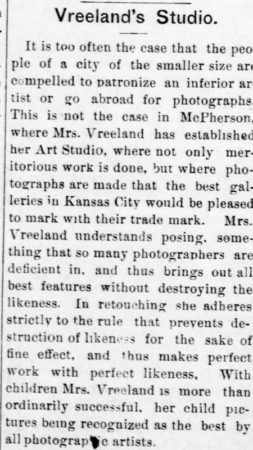
Selected examples of photos from Mrs. Rosa Vreeland’s various studios:
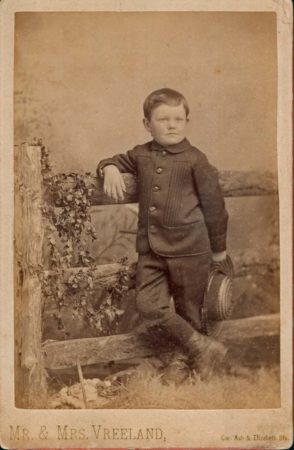
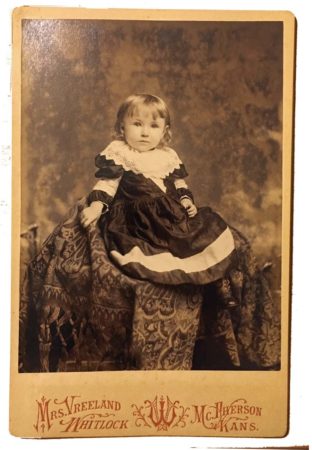
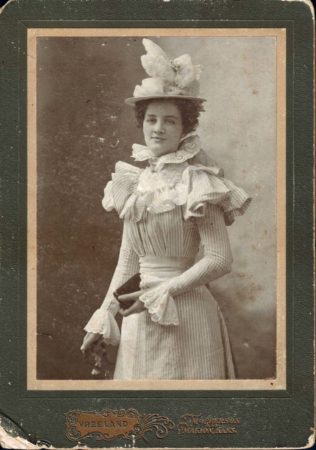
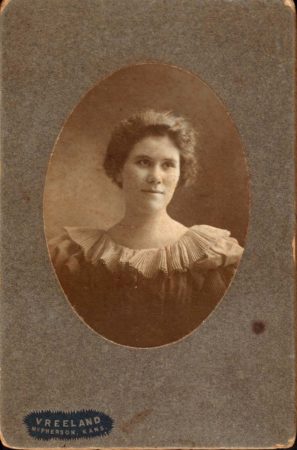
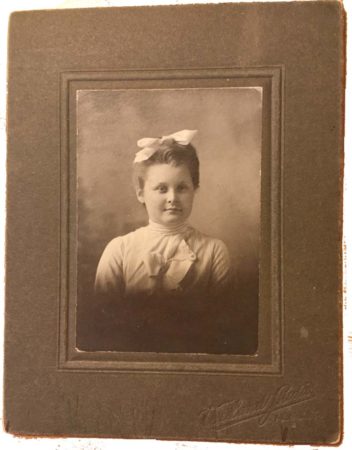
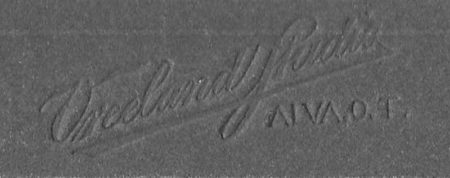
Examples of different types of advertising for Mrs. Vreeland’s studios:


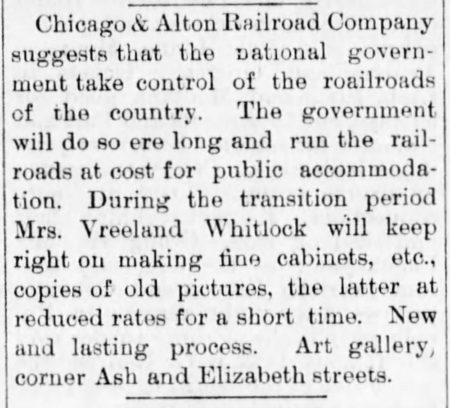



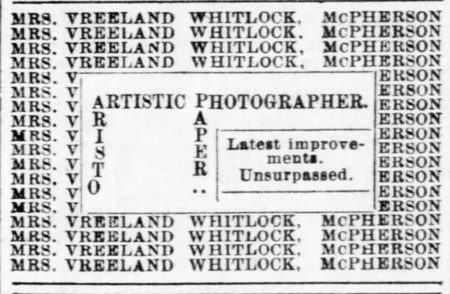
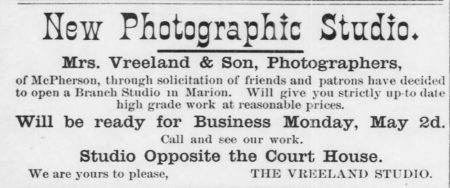
Recommended Links
- Local History Resources available online at the McPherson Public Lbrary – Visit
- Old Mill Museum website – Visit
- General online research sites used for today’s episode
- Ancestry.com (census records, city directories, and more; paid account required – Visit
- Family Search website has U.S. Federal Census and more; free account required – Visit
- Geneologybank.com has a selection of digitized newspapers from the United States; paid account required – Visit
- Newspapers.com has a selection of digitized newspapers from the United States; paid account required – Visit
- Newspaperarchives.com has a selection of digitized newspapers from the United States; paid account required – Visit
Transcript
You’re listening to Photographs, Pistols, and Parasols.
Support for this project is provided by listeners like you. Visit my website at p3photographers “dot” net for ideas on how you, too, can become a supporter of the project.
Welcome to Photographs, Pistols & Parasols, the podcast where we celebrate early women artisan photographers.
I’m your host, Lee McIntyre.
In today’s episode we’re going to meet the extraordinary early artisan photographer, and early photographic entrepreneur, Mrs Rosa Vreeland.
For more information about any of the women discussed in today’s episode, visit my website at p3photographers.net. That’s letter “p”, number “3”, photographers “dot” net.
*****
To introduce you to the subject of today’s podcast episode, Mrs Rosa Vreeland, I want to read you a notice that appeared in 1896 describing her studio:
The headline reads: Vreeland’s Studio
It says:
It is too often the case that the people of a city of a smaller size are compelled to patronize an inferior artist, or go abroad for photographs. This is not the case in McPherson, where Mrs Vreeland has established her Art Studio, where not only meritorious work is done, but where photographs are made that the best galleries in Kansas City would be pleased to mark with their trademark.
Mrs. Vreeland understands posing, something that so many photographers are deficient in, and thus brings out all the best features without destroying the likeness. In re-touching, she adheres strictly to the rule that prevents destruction of likeness for the sake of fine effect, and thus makes perfect work with a perfect likeness. With children, Mrs Vreeland is more than ordinarily successful, her child pictures being recognized as the best by all photographic artists.
While that’s a little over the top, you get the sense that Miss Rosa Vreeland is really very good at what she does, and she truly is an example of an extraordinary early artisan photographer and early photographic entrepreneur.
Now, last time I promised that we were going to leave Kansas.
But unlike Dorothy, we really are still in Kansas at the moment here with Mrs Vreeland.
We’re going to be traveling a little bit with her, but mostly, I have to admit, the story of her and her career really still is in Kansas.
While I was preparing for the next episode, I got to thinking that Mrs Vreeland actually is a great example of something that I’ve been mentioning a bunch here on the podcast, and that’s the notion of these multi-threaded narratives that run through the lives of all these early women photographers.
In some places like Blue Rapids, Kansas, and Lowell, Massachusetts, I found a wonderful group of different women who represent different parts of those threads; when you put them all together, you find them all [all the threads].
With Mrs. Vreeland, though, what’s really remarkable with her story is that all the different threads are all woven together just in her life and her career alone, and that’s what we’re going to talk about today.
Now the first thing to know about Mrs Vreeland is the longevity of her career.
She worked as a photographer, running her own studios, from 1881 until at least 1910/1911, so that’s at least thirty years, maybe longer.
She didn’t start being a photographer until she was already 29 [years old], at which point she was already a married woman and mother of two children.
Her primary base of operations for her photography career was in McPherson, Kansas.
I want to do a quick shout out of thank you to the librarians in McPherson, Kansas for helping me understand that — as they put it — there’s no “fear” in McPherson; that’s a great way to remember how to pronounce that town!
In general I don’t really get lucky like that, with somebody telling me how to pronounce the towns or the names of these old photographers, so if you ever do notice that I’m mispronouncing something, just drop me a line at podcast “at” p3photographers.net, or go to my Facebook page and leave me a note there, because I’d love to hear from you so that I can correct it.
Anyway, Mrs Vreeland was operating as a photographer in McPherson, Kansas starting in 1881.
During the time she was in McPherson, she was also running studios in other places all over Kansas, places like Salina and Hutchinson and Marion, among others as well as having studios in places like Colorado Springs, Colorado, and ultimately in Alva, Oklahoma.
That actually becomes her base after she sells the McPherson gallery in 1900.
Mrs. Vreeland even has a photo car at one point, that goes all over Kansas and the surrounding area.
In looking at all the different galleries that she ran, some of them simultaneously over this 30-year period, it’s really incredible.
It’s like she has a mini photographic empire.
Now, during her career she is active not only running the studio but also participating in events, like the photographers association conferences in Kansas.
We see a lot of the women photographers in Kansas very active in this organization.
Mrs. Vreeland not only is going to the conferences, but one year she’s actually elected as the second vice president of the organization.
But her primary photographic occupation is, of course, running the studios.
Part of her entrepreneurship is the ability to promote her brand by taking out ads in newspapers.
It’s really incredible to me to look at the digitized newspapers from Kansas and discover that for Mrs Vreeland, there are hundreds of hits for notices that are advertising her studios in all the different places that she operated in Kansas and beyond.
She starts small.
I mean her very first notice that I found just promises “good work” and “prices low” at Mrs Vreeland’s photograph gallery.
But later on she becomes more and more creative, really trying to explore how best to promote her brand, which is “Mrs Vreeland’s Photo Gallery.”
Now, at one point her brand changes slightly, and becomes “Mrs Vreeland-Whitlock”; that’s because in 1890 she gets married to a man named Ogden Whitlock.
Now, in the article about their marriage [in the newspaper], it talks about how he was working in Colorado Springs at a newspaper there, and she was working at a studio that she was running there.
I mean, she still had the place in McPherson, but she was also running this studio in Colorado Springs.
They meet, and they get married, and he quits his job and moves back to McPherson with her.
She’s got her photographic empire based really in Kansas.
And after their marriage she makes a deal to swap her Colorado Springs studio location for a studio in Hutchinson, Kansas, expanding her empire in Kansas, and making it perhaps more manageable to deal with now that she’s been remarried and no longer on her own there in McPherson.
It’s not that Mr Whitlock, though, was a photographer – he never joins her in the photography business.
Her first husband, Cornelius Vreeland, the man to whom she was married when she first started doing photography there in McPherson, well, he’s a farmer at the start of their marriage.
But after she starts her gallery, and presumably has some success, he quits his job as a farmer and joins her as a photographer.
They take out ads together in the newspaper promoting Mr and Mrs Vreeland, Photographers, and their gallery in McPherson.
In 1884 they also decide to open up a new branch in Salina, Kansas, running both [locations[ simultaneously.
It doesn’t last too long in Salina, though, because by the end of 1884 Mrs Vreeland takes out a notice that she’s closing that gallery in Salina.
What she doesn’t say, but probably everybody in town knows, is that the studio in Salina is closing because the Vreeland marriage has ended, and Cornelius and Rosa Vreeland are no longer together.
Cornelius does keep at photograph as a business; he actually moves to Westmoreland and Olsburg, Kansas and opens up studios there, and runs them separately from Mrs Vreeland.
Eventually he remarries — but not to a photographer — and he moves eventually, in 1894, to San Diego, moving away from Kansas altogether.
1894 is actually a pivotal year in Rosa’s life as well.
As I mentioned, in 1890 she married a man named Ogden Whitlock, and she had rebranded her gallery as “Mrs Vreeland-Whitlock” to reflect her new married name, while keeping her old “Mrs Vreeland” brand that was associated with those good photos that she was taking.
Unfortunately, in 1894 that marriage to Mr Whitlock, that doesn’t end well.
Rosa sues Ogden for divorce on the grounds of abandonment and cruelty.
When that marriage breaks up, and she’s ready to rebrand her studio yet again, her son George actually comes back to town.
He’d left [Kansas] in 1890, when his mother remarried.
Maybe he didn’t get along too well with Ogden Whitlock himself?
There are notices in the newspaper at that time that George is actually off to study how to do photography with other photographers, first in Texas and later elsewhere.
But in 1894, son George comes back to McPherson and is ready to join his mother in the photography business.
So they take out a new ad: the studio is now called “Mrs Vreeland and Son”.
They’re very prosperous for a few years working together in the studios both there and elsewhere.
They open up studio in Marion at one point.
And, at one point they close the studio in McPherson for a short while, saying they’re going on vacation.
But in fact, what they’re really doing is going over to a little town of Windham, where they set up shop for just a couple of weeks.
It’s just a temporary little shop; it’s what we would call today a “pop-up” shop, that is there just to take photos for a little bit before they go back to their main place in McPherson.
George is still there when Mrs. Vreeland operates that photo car that I mentioned, because that’s circa 1900.
By that time they are operating the places in Marion, and McPherson, and as well as the photo car.
George continues to work with his mother until she sells the studio in McPherson around 1900.
At that point she’s actually met a new man, J.C. Herron.
They get married and move to Alva, Oklahoma
J.C. Herron is actually Dr. J.C. Herron.
He’s a dentist, not a photographer.
Rosa sets up a new studio in Alva, Oklahoma and runs that for at least another ten years.
Along the way, both in Kansas, and Colorado Springs, and in Oklahoma, her story not only intersects working with some members of her family (specifically her first husband and her son), but also working with many other photographers, giving them a start in the business, including many other women photographers.
There were women like the sisters named Minnie Young and Stella Young.
They are from McPherson, and they actually work for Mrs Vreeland for a little while before buying the studio, when she sells it in order to move to Oklahoma.
The Young sisters proudly proclaim that George, Mrs. Vreeland’s son, is going to stay there in McPherson, helping them out at the beginning, so they are going to be able to provide wonderful service just like Vreeland studio has always done.
I found it funny that in the first ad for the studio it’s billed as not the “Young Sisters” or the “Misses Young”, but “Miss Minnie Young and Sister,” following the model of “Mrs Vreeland and Son.”
Stella, the “Sister” that’s not named in that initial ad, she actually continues running that business after her sister Minnie gets married just a couple of years after they start running the studio.
Another woman photographer that works for Mrs. Vreeland is a woman named Leora Seitz.
Now, Leora Seitz wasn’t always a photographer.
Her career before she worked for Mrs Vreeland was actually that of deputy sheriff for the county.
Which I find really intriguing: a woman was actually employed as a deputy sheriff?!
Well, once Leora becomes a photographer, she keeps at it for a few years.
She leaves Kansas when Mrs Vreeland does, but she doesn’t follow her to Alva.
Rather, she goes to Kingfisher, Oklahoma, and works for two sisters who actually had also worked for Mrs. Vreeland, sisters named White, who open up their studio in Kingfisher around 1901.
So, that notion of women photographers training and working with other women photographers is something that we definitely find in Mrs. Vreeland’s story.
But I want to go back to the idea of her ads in the notices in the newspaper, because as I said, there are 100s of them.
I am not going to read all of them to you, but I wanted to point out just a couple of things that make her ads a little more unique from some of the other women that I’ve been talking about.
Rose Vreeland has the standard thematic ads, i.e. the ones such as “Come in get your Easter pictures taken,”, or “Come and get pictures taken to send as Christmas presents!”, etc.
But she also has kind of a poetic bent to some of them.
I mean, there are some that talk about “time slipping away”, so you don’t want to wait to get your picture taken.
She also at one point has the motto “secure the shadows, ‘ere the substance fades.”
She has a notice that talks about photography and the importance of the photograph itself.
Let me just read you this one.
It says,
Of paramount importance is expression. The man or woman whose expression is natural, and hence correct and gracious, is eminently rich in the position of dignity and excellence of character. Expression is key to character. Think of this, then have Mrs Vreeland-Whitlock take your picture.”
It’s a great ad, because it’s talking about the aesthetic quality of the photo, which you don’t see a lot of these early women photographe able to emphasize in their ads.
There’s another one that I like when she’s going off on vacation, and even that’s a little bit unique.
There’s this big bold headline that just says
PRO-CRAS-TI-NA-TI-ON
And in smaller type it says
Is dangerous. June 1, expect to close my gallery for a vacation so do not postpone having your pictures taken until “too late”.
Most of the photographers are just going to post a notice that says, e.g. I’m gonna be closed from June 1st to June 30th, come get your photos taken before then, or come see me afterwards.
Bt not Mrs Vreeland: she has a little bit more interesting take on that kind of notice.
There are also some other notices when she is operating as Mrs. Vreeland-Whitlock in the early 1890s.
I hadn’t seen this type of ad before, but it’s taking a current event and then writing a little notice that grabs your attention with the current event.
And then talks about getting your photo taken.
Let me just read you one of them.
It says,
Chicago and Alton railroad company suggests that the national government take control of the railroads of the country. The government will do so ‘ere long and run the railroads at cost for public accommodation. During the transition period, Mrs Vreeland-Whitlock will keep right on making fine cabinets, etc., copies of old pictures, the latter at reduced rates for a short time. New and lasting process. See her at the Art Gallery, corner Ash and Elizabeth streets. <\em>
So it’s the idea of something that’s on the public mind being tied in to getting your picture taken in Mrs. Vreeland’s gallery.
And, really, there’s no connection between the two, but Mrs. Vreeland has got an interesting marketing hook to get people to notice her ad, and then keep reading to find out that she’s discounting things and doing all these wonderful things like cabinet cards and copies of old pictures.
Actually, she has a really interesting ad at one point for making copies of old pictures.
I should point that making copies of old pictures was something that I haven’t really mentioned as something that these photographers did, but the idea of taking a photo into a gallery and having the photographer make a copy of that photo, that was actually quite popular in the late 19th century.
Because you might have had old tin types that would have been taken and that was a kind of photo that could not easily be reproduced on its own, as there was no negative.
So instead, you take it in and have it photographed, and then a new photograph would be made from this old photograph
Mrs. Vreeland is really emphasizing that that’s part of her business.
Very intriguing, very creative, and very eye-catching to talk about it like she does in her ads.
The headline on a little box ad is called Mother’s Picture.
And there’s a little poem …
I bring you the picture of mother dear
Taken so long ago
It is scratched and faded as you see
But is all I have you know
Take out the wrinkles in the dress
And add a collar please
Leave the dear hands as they are
They look so much at ease.
The expression I would not have changed
Nor the hair so streaked with gray
But make the eyes as good as you can
For they were bright as day.
That’s kind of sweet.
It not only emphasizes the idea of getting a copy made of an old picture of your mother, but also sort of subtly implying that Mrs. Vreeland can actually do this kind of retouching that was popular then.
We don’t think about the fact that photographers in the 19th century were doing retouching.
They were adding color, little bits of color, or they were trying to clean it up, remove the dust and scratches, smooth out the hair styles, smooth out the dresses, anything that you wanted they could try to do.
And so this little poem talks about that in a very creative way.
There’s another interesting ad that she takes out there reminds me of the ones that are later on, during World War I, when the photographers are emphasizing, e.g. Come your picture taken so that you can send it to the boys overseas!
Mrs. Vreeland, though, takes out an ad in the 1890s that emphasizes the same concept of sending your picture to somebody, but with a slightly different twist.
Let me read you this one. It reads,
A young lady in London, who was crowded by engagements, could not attend the wedding of a dear friend. She had her own photograph taken, and sent it together with her good wishes to the bride on the eventful day. This is a matrimonial invention that is worth something, and Mrs Vreeland-Whitlock rejoices and is exceedingly glad that she has lived to see this day! All the photographists rejoice, for the fashion set by this London lady will be followed numerously, and the picture-taker’s business will be good from this time forth.
Well okay, it’s a little over the top, and that “new idea” of getting your picture taken to send to somebody whose wedding you can’t go too, well, that is a very different twist on who you might want to send a copy of a picture of yourself to.
But I just like how this is just another creative piece of advertising Mrs Vreeland Whitlock’s services.
The other fun thing about that notice is that it uses the term “photographist”, which is an alternative to “photographer”.
I gather from reading all these old newspapers that at the beginning they were not quite sure which word they were going to use, whether it’s was going to be “photographer” or “photographist”.
So, you see both of them on and off until “photographer” clearly wins out after a certain point.
Now another thing in Mrs Vreeland’s notices which emphasizes her skill as a photographer is that she is constantly advertising that she’s keeping up-to-date and offering the latest in technology.
So, for example, the “dry-plate” work can be done in Mrs Vreeland’s.
That’s the new style photography done after the wet plate photography (the type I talked about back with Elizabeth Withington, episode [c.f. Episode 09: A Sensible Woman, which was much more cumbersome for the photographers to use), but it also gave different results, so people knew that there was a difference, and I guess they would look for a photography gallery which could do all the latest and greatest things.
I love one little ad where she’s advertising that you should come in and bring your baby, because she’s got that “patent baby holder”, and you could try it out!
She also is using some sort of fancy paper called Aristo paper at one point (again, in the period when she’s Mrs. Vreeland-Whitlock).
She has really creatively ad layouts, that almost remind me of the kind of computer printer art people used to do, when you would print out multiple words over and over to create a pattern.
Anyway, I’ll put the ad up [in the episode notes].
It’s her name written over and over, with interlocking words that talk about how she does artistic photography with this Aristo paper.
It’s very creative, very eye-catching.
Now, she opened her original studio in Kansas, of course, in 1881, and then in 1901 she moves to Oklahoma.
She opens up a new studio in Alva, Oklahoma.
It’s the Vreeland studio.
Again, her brand was Vreeland Studio, even though she is now personally Mrs J. C. Herron, her final married name.
The Vreeland studio is in operation in Alva, Oklahoma long after 1910. I’m pretty certain that she is still running that studio as late as 1911, but I’m not sure when exactly she sells out and retires.
After she stops running the studio in Alva, she retires and lives with her husband until his death in 1918.
After she’s widowed, she seems to move in with her daughter, Lila, in Texas.
There’s no evidence that Rosa is ever a photographer, though, in Texas when she moves in with Lila.
There’s also no evidence that Lila was ever herself a photographer, even though her brother went into the business.
The most I’ve ever found about Lila having anything to do with Vreeland Studio is walking around one day wearing a photo advertising dress, which was a dress where they pinned photos to the dress, and then the woman walked around with a banner with the name of the studio that had produced all the photos that she was wearing.
Anyway, that’s the only connection I’ve found so far with Lila directly with the Vreeland Studio operations in McPherson, or anywhere.
Now in 1924 Rose Vreeland Herron gets gets sick, and she moves to California to live with her son, George.
George actually had opened up his own studio in Enid, Oklahoma, after his mother opened up her studio in Alva, Oklahoma.
Those studios were separate, though, and at some point George closes his studio in Oklahoma and moves to San Diego.
I’m not sure if it’s a coincidence that that’s where his father, Cornelius Vreeland, had moved years before.
In any case, George opens up a studio in San Diego that ultimately is there for over 60 years, run first by him (and — for part of the time, by him with his father), but also later with his son, George, Jr.
Anyway, when Rosa is sick in 1924, she moves to San Diego to live with George.
And then, on October 29, 1925, Rosa E. Burgess Vreeland Whitlock Herron in dies at the age of 73.
Her death brings to a close the life of this extraordinarily prolific, and truly remarkable early woman artisan photographer and photographic entrepreneur.
*****
Just a couple of final things about George.
As I said, he was living in San Diego, and his father, Cornelius Vreeland, was living there as well.
And his father does come and work with him for a time.
Cornelius Vreeland dies in 1935, 10 years after Rosa.
And when Cornelius is buried, George has him to be buried in the same grave – at least, seemingly the same plot – as Rosa Vreeland Herron.
In other words, George reunites his parents after they’re gone.
It seems kind of sweet but also a little bit odd, in that Cornelius had remarried, and his wife died in 1917, and she’s actually buried in that same place, too.
I like to think that they all had a very amicable relationship toward the end of their lives.
One can only hope that George knew what he was doing when he buried them all together.
The other thing I want to mention about George is that way back when he went off to study photography — seemingly when his mother got married to that Ogden Whitlock — he’s off, studying photography all over the place.
At one point, when he comes back and joins his mother, they make a big deal in a notice in the paper that talks about how he has gotten all of his artistic ability from studying photography with a studio called the Chase studio in Denver, a studio that they said has a national reputation of artistry.
What’s curious to me to run across that is that it actually provides a crossover point with another woman photographer that I’ve been exploring.
Now, it is rare for me to find these crossovers that intersect the two stories of two women who never worked together, who hadn’t marry the same man [cf. Episode 07 – A Tale of Two Townes] and/or weren’t otherwise related.
But in this case, the Chase studio in Denver, in the period where George Vreeland, Rosa Vreeland’s son, would have studied there … well in that period it was being run by a husband and wife: a man named DB Chase, and a woman named Belle B. Chase.
And Belle B. Chase is going to be the subject of the next episode.
She didn’t have quite the empire, or the number of outlets, that Mrs Vreeland had.
But she still had quite a long and interesting career.
Now, I will warn you, her career does start in Kansas, but it will quickly take us all over the place, around the country … and around the world.
But that will be next time, here on the podcast.
****
Before I end today, I want to say a few thank yous to people who have helped.
First of all, Jenny and the other librarians at the McPherson Public Library.
I want to thank them not only for that mnemonic about how to pronounce the town’s name, but also for all their help picking out little articles and other material that they found in the databases and archives there at the McPherson Public Library.
I also want to thank Sheila from the Old Mill Museum in Lindsborg, Kansas.
Mrs. Vreeland never actually worked in Lindsborg.
But it turned out that in the Old Mill Museum, there were some lovely examples of photos by Mrs Vreeland from different points in her career, including one by Mr. and Mrs. Vreeland.
As always, I’m going to be sharing photos, as well as those newspaper articles and some of the ads that I read today on the podcast in the episode notes for today’s episode at my website.
As usual, that will all be available on my website, at p3photographers.net. That’s letter “p”, number “3” photographers.net
Also, don’t forget you can drop me a line at podcast “at” p3photographers.net.
And follow me on Facebook, at facebook.com/p3photographers.
Mrs Rosa Vreeland is really one of the most impressive business woman I’ve encountered so far, given that she was able to reinvent herself and rebrand herself, but still keep a successful business going for thirty years.
I’m hoping to have some time at some point to figure out just how many galleries she was juggling there in Kansas in all those little towns.
I haven’t figured that out yet, but I’ll let you know if I do.
But next time we’re off on the hunt for the marvelous Belle B. Chase.
Her story will start in Kansas, but we really will be leaving Kansas next time.
I hope you’ll join me.
Thanks for stopping by.
Until next time, I’m Lee and this is Photographs, Pistols & Parasols.
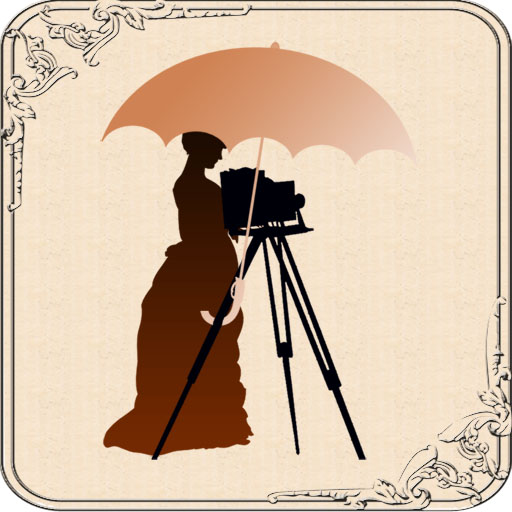

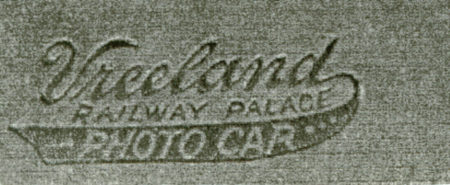

2 thoughts on “21-The Extraordinary Mrs. Vreeland”
Comments are closed.